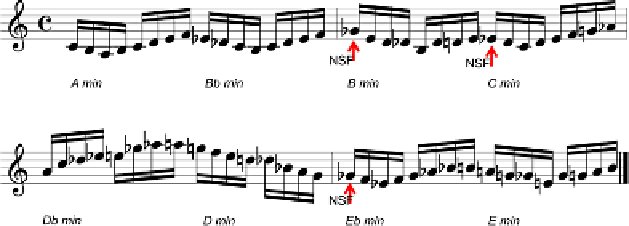Information Technology Reference
In-Depth Information
Fig. 5.13
A generation using only the harmonic scale as training base, on a succession of minor
chords progressing one semitone up. NSF are indicated at chords #3, #4, and #7
in
A minor
containing a
C#
or an
A#
(i.e.
B
in
A# minor
, once transposed in
A
): an
interesting case indeed, which forces the use of chromaticisms or passing notes in
a clever fashion. Figure
5.13
shows a more complete example on a succession of
chromatically ascending minor chords.
It is interesting to note that this approach to the NSF problem corresponds to the
pedagogical strategy proposed by Pat Martino (
1994
): learn only one scale (minor),
but learn how to use it on any chord change to another minor chord. This implies
practising over 12 possible changes from one minor scale to another one, in all keys,
so a total of 'only' 132 cases from which any chord sequence can be smoothly ne-
gotiated (Pat Martino proposes a solution to substitute any chord by a minor chord,
see Sect.
5.4.2
).
Other strategies could be used, such as simply finishing the phrase. However, this
kind of heuristic gets in the way of our modelling goal: the decision to stop or end a
sentence is a 'high-level' one that should not rely solely on such low-level technical
considerations, but only on the musical intention of the musician.
This mechanism produces phrases which satisfy local harmonic constraints,
chord negotiation and continuity. However, the phrases wander up and down ac-
cording to chance, and there is no direct means of controlling their structure. In
some sense, this represents
technical virtuosity
(the ability to play fast), but not
con-
trolled virtuosity
(the ability to play what you want). This most important issue is
addressed in Sect.
5.5.2
.
5.4.4 An Example Training Set
Obviously the choice of training phrases is crucial to the generation, as only these
phrases are used to build the improvisation. Experiments using inputs entered in
real time are problematic as errors cannot be corrected once learned by the system.
Markov models have not been used, to our knowledge, in a
controlled setting
for
jazz improvisation. Here again, the particular context pushes naturally to a careful
selection of training patterns, like human improvisers do when they practice. But
which phrases are the right phrases?

